This post may contain affiliate links. Please see our disclosure policy.
Rhubarb Jelly captures the fresh flavor of spring rhubarb in a smooth, luscious jelly that’s perfect on toast, in thumbprint cookies or simply stirred into a warm mug of tea.
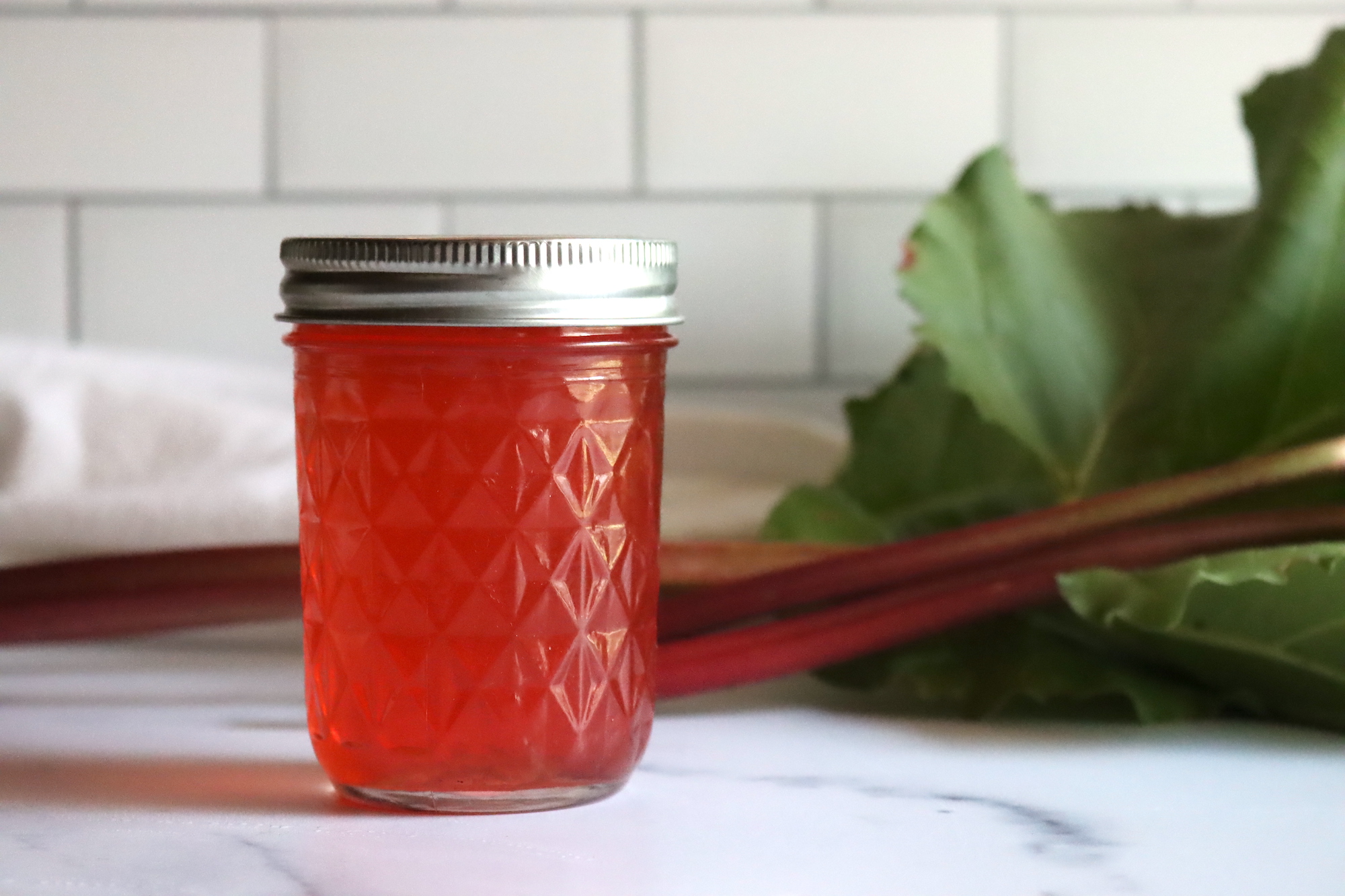
There’s something about a homemade jelly that captures the essence of the fruit, and converts it into a luscious spread that can elevate a piece of toast…without the distraction of chunky fruit.
Don’t get me wrong, I love chunky fruit jams, and I always make rhubarb jam (and strawberry rhubarb jam) each year, but there’s something to be said for a preserve that captures the essence of a fruit as perfectly as a jelly.
And while I love both jams and jellies, my kids are all about jellies, and like good Vermont farm kids they’ll pluck and eat stalks of fresh rhubarb right out in the garden…so this one’s got their name on it!
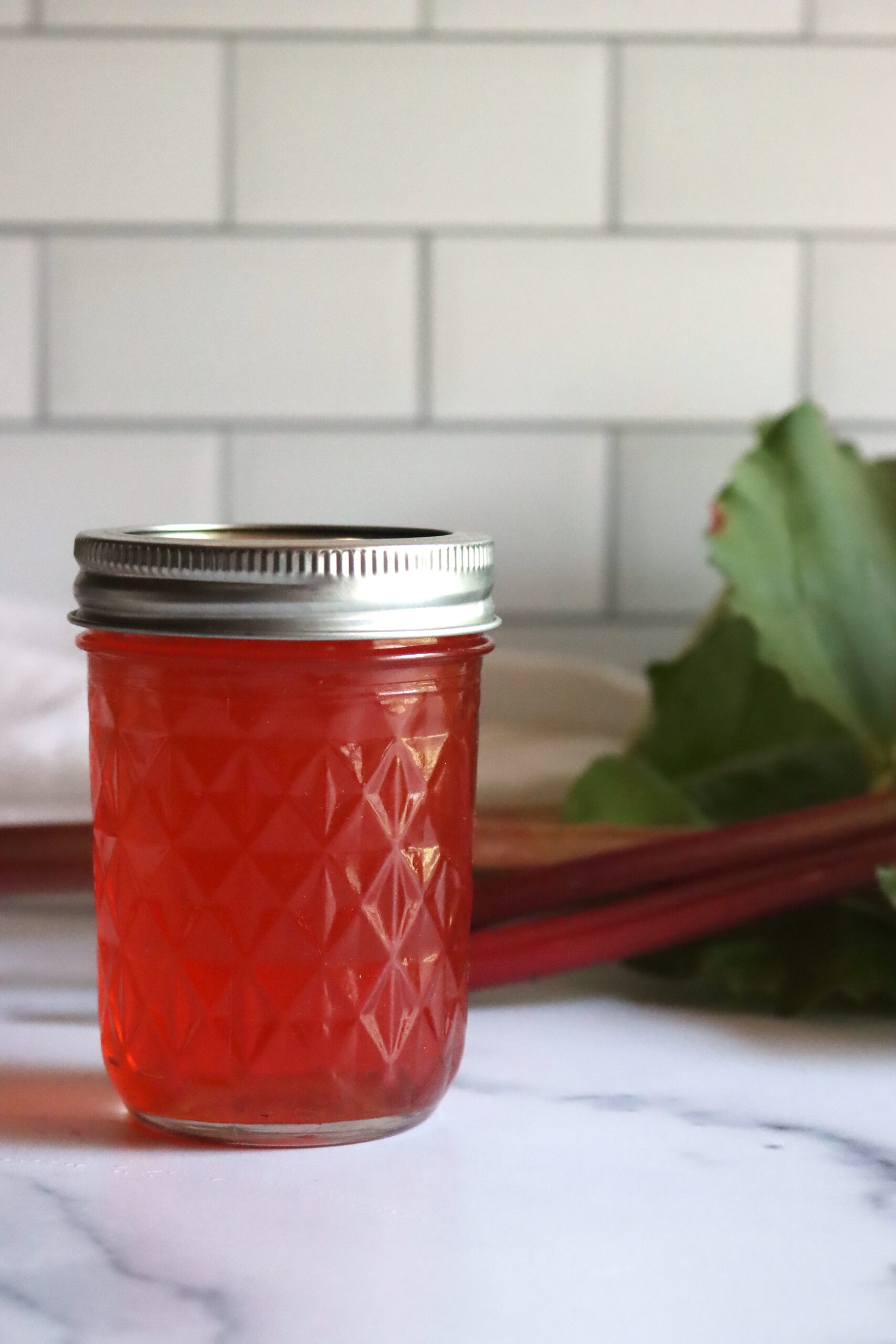
Ingredients for Rhubarb Jelly
Rhubarb makes a beautiful red jelly that is tart and flavorful. This recipe for rhubarb jelly is adapted from Food In Jars: Preserving in Small Batches Year Round.
To make 4 half-pint jars of rhubarb jelly, you will need the following:
- 1½ lbs. rhubarb
- 4 cups granulated sugar
- One package powdered regular pectin like Sure-Jell (1.75 oz.)
Fresh rhubarb provides a tangy, rich juice that makes this jelly stand out. Rhubarb is typically one of the first perennials sprouting in the spring, and this jelly recipe reminds me of spring all year round.
We use regular pectin for this recipe, and I have always found Sure-Jell to be a reliable brand for pectin. Sure-Jell also makes a Sure Jel Low Sugar (in a pink box), which can also be used in this recipe. You would reduce the sugar to somewhere between 1 and 3 cups of sugar for low-sugar pectin (but you’d get a smaller yield).
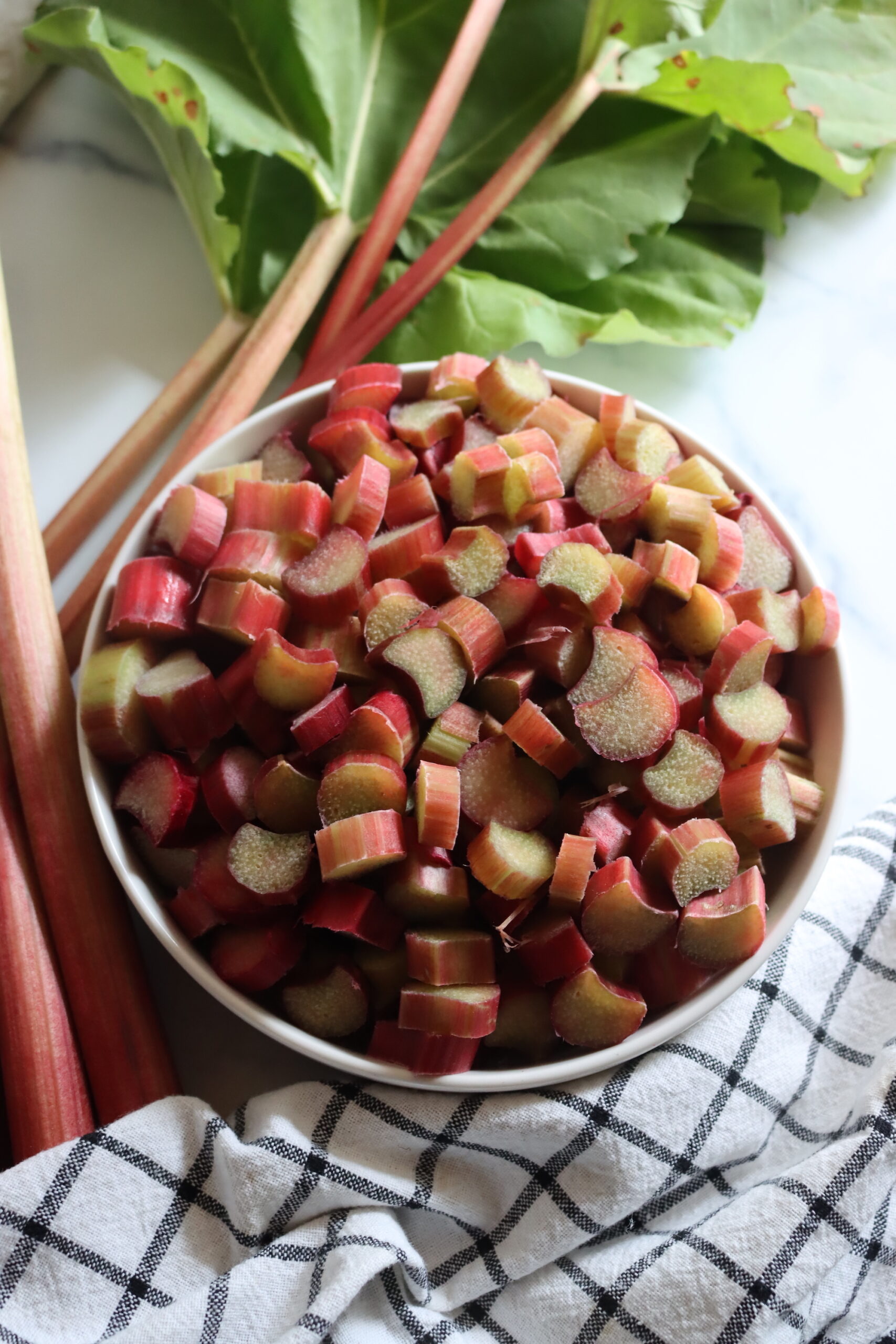
How to Make Rhubarb Jelly
Trim the leaf and root tip off the rhubarb stalk and any brown or damaged spots. Wash the rhubarb by rubbing it with your hands under cool water.
Chop the rhubarb and place it in a large saucepan or jam pot. Add 3 cups of water to the rhubarb pieces.
Cook the rhubarb and water or medium-high heat until it reaches a low boil, then reduce the heat. Cover and simmer the rhubarb for 15 to 20 minutes, or until the pieces of rhubarb have broken apart entirely and the water is bright pink.
Line a large, fine mesh strainer or sieve with cheesecloth and place it over a large bowl to capture the juice.
Pour the cooked rhubarb into the cheesecloth-lined strainer and allow the juices to drain through for 1-2 hours or more.
Do not squeeze the cheesecloth or press the rhubarb if you want clear jelly. Forcing more juice out of the rhubarb pulp will cause some fine pulp to pass through the cloth, and you will still have great-tasting jelly, but it will be cloudy.
Prepare your jars, lids, and equipment for canning. See my Beginner’s guide to water bath canning for additional information.
Measure 4 cups of rhubarb juice and discard the rhubarb solids.
Pre-measure 4 cups of sugar (or less if using low-sugar pectin) and set aside. Do not add it to the juice yet.
Pour the 4 cups of juice into a medium saucepan or jam pot.
Place the pan with the juice on the stove and cook the liquid over medium-high heat until the mixture comes to a boil, stirring occasionally.
Slowly add the powdered pectin, stirring continuously to dissolve.
Bring the mixture to a full boil, and continue to boil for one minute, stirring continuously.
Slowly add the pre-measured sugar, continuing to stir as the sugar dissolves and the juice returns back to a full boil.
Boil the jelly for 1-2 minutes. Then remove the pan from the stove.
Carefully ladle or pour the mixture into your prepared hot jelly jars, leaving ¼ inch of space at the top of each jar.
Wipe the rim of the jars with a clean cloth, and using 2-part canning lids, place the lid on the jar and then screw on the ring, tightening only until finger-tight.
At this point, your jelly is done, and you can proceed to canning with a hot water bath or let it sit undisturbed on the counter for 24 hours or more until the jelly has set. Store this jelly in the refrigerator for up to 1 month, or keep it frozen for up to 6 months.
For canning your jelly, instructions are below.
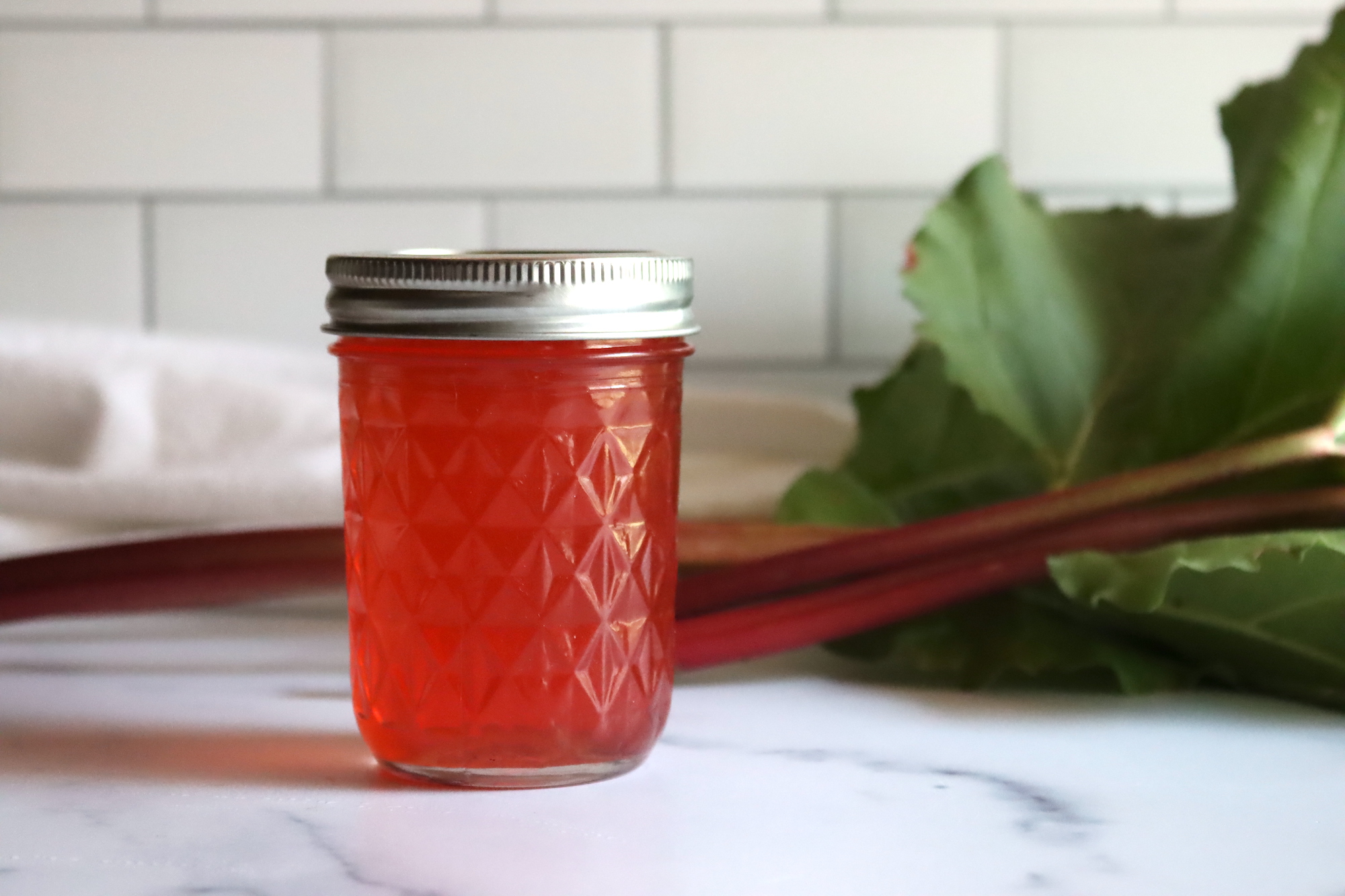
Canning Rhubarb Jelly
For people who have not used a hot water bath to can jelly, please read my Beginner’s guide to water bath canning before you start.
Prepare your jars and lids, and have the hot water bath boiling.
Once the jelly has reached the gel stage, carefully ladle the jelly into the hot jars, leaving ¼” headspace at the top of the jar. Use a canning funnel for this process to prevent or minimize spills, and it can be helpful for measuring the correct amount of headspace. It is imperative that you leave ¼” of space at the top of the jars for successful canning.
Wipe the rims of the filled jars with a damp, clean cloth and apply 2-part canning lids. Tighten the canning rings only until “finger-tight.” Over-tightening the rings may also result in jars that do not seal properly.
Load the filled jars into your preheated canner and bring the canner to a full rolling boil. Once boiling, process the jars for 10 minutes (or 15 minutes if above 6,000 feet in elevation).
After the jelly has finished processing, turn off the heat and allow the jars to set in the water for an additional 5 minutes.
Once the time has elapsed, remove the jars from the canner using a jar lifter. Set the hot jelly jars on a towel on the counter, leaving space between the jars for airflow as the jelly cools. Leave the jelly jars undisturbed for 24 hours, and then check the lids to ensure they have been sealed. Store any jars that did not seal in the refrigerator for immediate use.
Store your canned jelly in your pantry or other cool, dry place. It will maintain good quality on the shelf for about 18 months but will still be good after that as long as the jar remains sealed. Refrigerate after opening.
Rhubarb Jelly Variations
Rhubarb’s tart and crisp taste is great as it is, but some variations can be made to the recipe to change the flavor, typically providing a little sweetness to offset the tart taste of rhubarb.
Replacing some of the rhubarb juice with apple juice will achieve a lighter jelly, both in color and taste.
Adding fresh strawberries or raspberries to the rhubarb and water mixture will produce a juice with a great red appearance but with a sweet berry flavor to compliment the rhubarb.
Spices that combine well with rhubarb include cinnamon, mint, ginger, and vanilla.
Honey is also a great compliment to rhubarb and can be added when sugar is added to the juice and cooked. Depending on how much honey you plan to use, you will want to reduce the sugar slightly.
Ways to Use Rhubarb Jelly
Scones, English muffins, biscuits, and many breads can be enjoyed with rhubarb jelly.
Rhubarb jelly can make a delicious glaze for grilled meat, such as chicken or pork. Mix jelly with honey and brush on the meat while grilling.
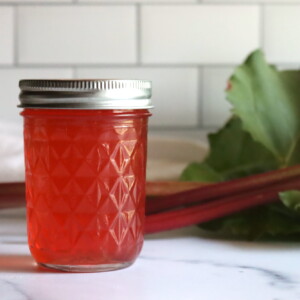
Rhubarb Jelly
Ingredients
- 1½ lb rhubarb
- 4 cups granulated sugar
- 1 box powdered pectin, 1.75 oz.
Instructions
- Cut off the leaf and root end of the rhubarb stalks, then wash the stalks under cool water.
- Chop the rhubarb and place it in a large pot. Add 3 cups of water to the rhubarb in the pot.
- Place the pot over medium-high heat, and bring the rhubarb to a low boil. Watch this carefully as rhubarb tends to foam up and overflow the pot quickly when it begins to boil. Stirring regularly will help keep the foam down.
- Reduce the heat and simmer the rhubarb for 15 to 20 minutes, or until the rhubarb has completely broken up and the liquid is bright pink.
- Using a fine mesh strainer or sieve, line the strainer with cheesecloth and place a large bowl under the strainer to capture the juice. Pour the rhubarb mixture into the strainer and allow the juices to drip through, for 1-2 hours or more.
- Measure out 4 cups of juice and pour into a medium jam pot or saucepan.
- Measure 4 cups of sugar and set aside, or 2 ½ cups if you use low-sugar pectin.
- Cook the juice over medium-high heat until boiling, stirring frequently.
- Stirring continuously, slowly add the powdered pectin to the boiling juice, dissolving the pectin.
- Allow the juice with pectin to boil for one full minute.
- Add the sugar slowly to the boiling juice, stirring continuously as the sugar dissolves.
- Bring the mixture back to a hard boil, stirring while boiling for 1-2 minutes.
- Pour the hot jelly into prepared jelly jars using a canning funnel, leaving ¼" headspace, and wipe the rims of the jars with a clean cloth.
- Secure lids to the jars and continue the canning process using the hot water bath method. If canning, process jars in a water bath canner for 10 minutes (or 15 minutes if above 6,000 feet in elevation).
- If you do not plan on canning your jelly, leave the jars to cool on the counter until the jelly has set, for 24 – 48 hours. Jelly that has not been canned should be stored in the refrigerator for up to 1 month or in the freezer for six months. Jelly that has been processed and sealed using a canning method can be stored in a cool, dry place, where it will maintain quality for 18 months. For all jelly, refrigerate once opened.
Notes
Nutrition
Nutrition information is automatically calculated, so should only be used as an approximation.
Spring Jelly Recipes
This season is the perfect time for stocking your pantry full of homemade jelly!
Rhubarb Canning Recipes
Need a few more ways to put up a bumper crop of rhubarb?
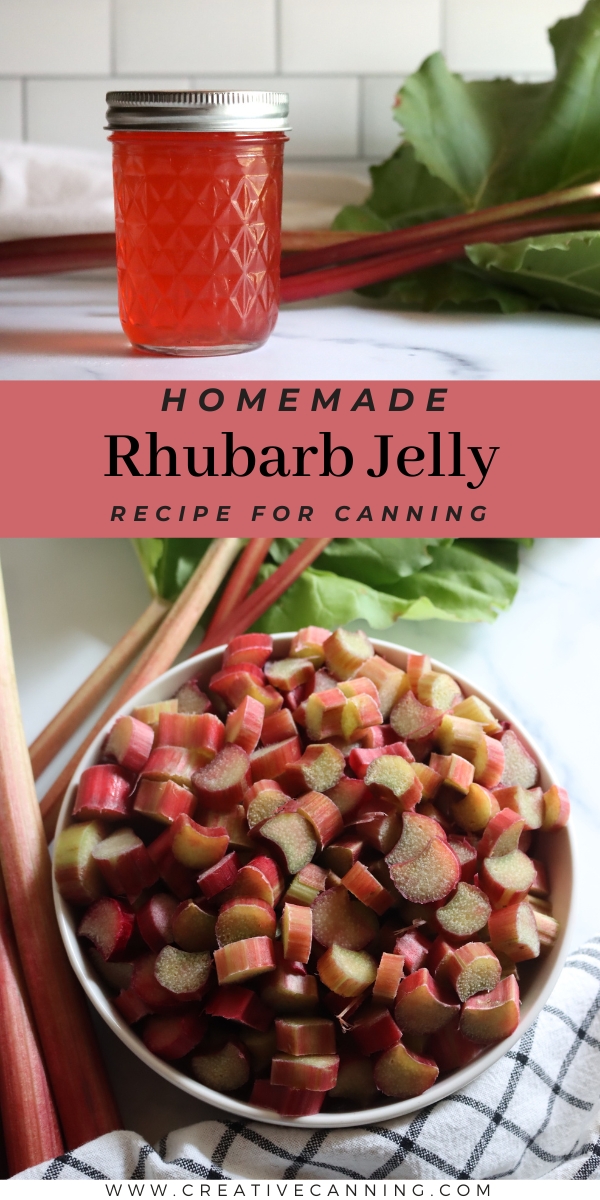
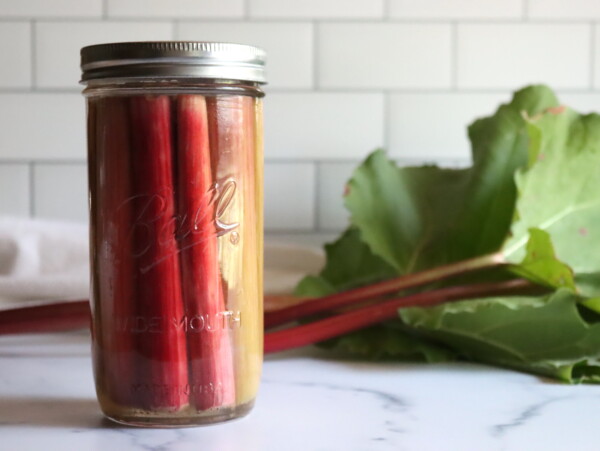
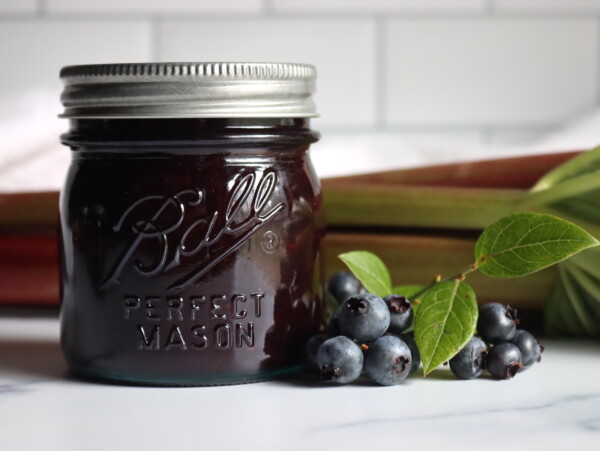
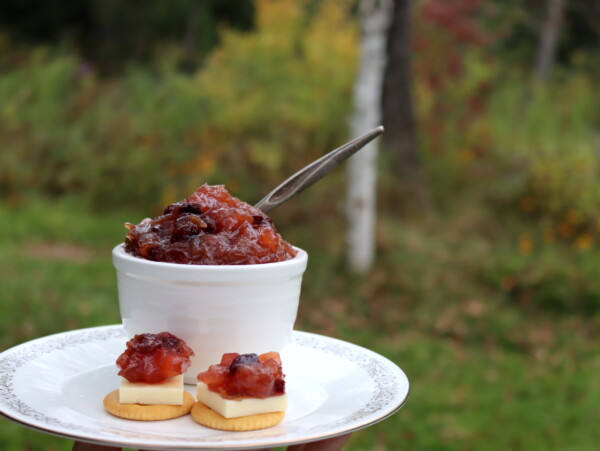

Instead of juicing the strawberries, could I just puree them and mix them with rhubarb juice?
Yes, you could make this with a mixture of strawberry puree and rhubarb juice. Both are fine for canning. What you’ll want is a total of 4 cups of juice/puree to one box of pectin. Enjoy!
Fabulous recipe! Thank you very much. I made my first batch and it set beautifully. A nice jelly, soft but still firm, tart and sweet at the same time.
Lovely! So glad you enjoyed it =)
Love the recipe I am on my third batch thank you so much
Great to hear it!